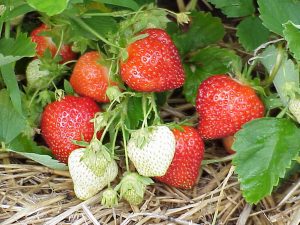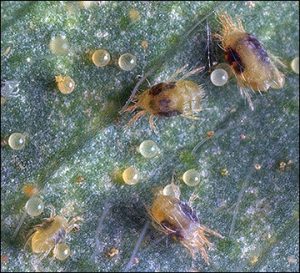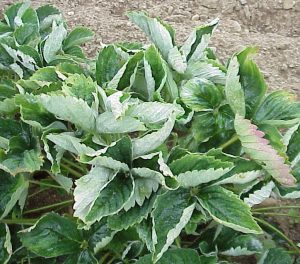Strawberry IPM Newsletter No. 3 – June 3, 2022

Strawberry IPM Newsletter No. 3 – June 3, 2022
Click on photos to enlarge.
INSECT PRESSURE REMAINS LOW IN MOST FIELDS
Managing Gray Mold Should be a Priority During Bloom.
REMINDER: Spring Growers’ Twilight Meeting – Bell’s Farm, Auburn – June 7 at 6 pm.
Situation:
Cool, mostly dry weather has strawberries ripening at a good pace. Early fields are being spot picked this week, prior to opening for pick-your-own customers. Growers have expressed some concern about berry size this spring. Regular irrigation, in lieu of adequate rainfall, can help promote strawberry size. However, overhead watering during fruit development can also encourage gray mold. The best time to irrigate is in the morning, leaving plenty of time for the plants to dry before evening. Watering late in the day will result in the plants staying wet through the night and allow more time for fungal diseases to develop.

Two-spotted spider mites: We continue to find mites in most of the fields we’ve scouted this week. Cooler weather seems to have slowed their development, however, as most fields were below the control threshold. We have also been seeing more predatory mites on the leaves, which may be helping keep the population down. Warm, dry weather can allow mites to build up rapidly, so growers should continue scouting for mites right up to harvest.
Strawberry bud weevil: Most fields in southern and central Maine are now beyond the stage when clipper can have any significant impact on yield. However, clippers may still threaten late-blooming varieties in northern sites that are still in the early stages of bloom, so those fields should continue to be scouted for clipped buds until they have reached full bloom.
Tarnished plant bug activity remained low in most fields this week, with one field in Dresden over threshold for nymphs in a field at full bloom. Growers should continue to scout for the active, yellow-green nymphs through petal fall to prevent injury on later ripening fruit. It is important to scout often, as they may appear very quickly in warm, dry weather. Insecticide options for tarnished plant bugs include malathion, Assail®, Brigade®, Bifenture®, Dibrom®, Danitol®, and PyGanic®.
Cutworms in Strawberry Fields: Bloom is a time when cutworm injury can occur on strawberry leaves and flowers. Cutworms are small caterpillars with smooth skin and a range of colors, including green, gray, and brown. They chew large, ragged holes in the leaves and sometimes feed on the yellow center of the flowers, called the receptacle, chewing a large groove in it, which often dries to a light brown or gray color. The remaining portion of the receptacle may develop around the damaged tissue resulting in berries with large creases or folds and poor size. I have seen a little cutworm injury in fields in southern Maine this spring. Keeping weeds out of your fields can help reduce cutworm problems. Pre-bloom insecticide sprays for clipper may also provide control of cutworms.
Thrips are tiny, slender, cigar-shaped insects that feed on the flowers and developing fruit of many plants. On strawberry flowers and fruit, thrips feed on the tissue between achenes (seeds) as the fruit expands. These insects are often overlooked because they are very small and hide within the flowers. Damage from thrips is most often seen as dullness or bronzing of the fruit surface as a result of feeding. Fruit cracking has also been reported. Light infestations may go unnoticed, but yield reductions of over 80% have been reported as the result of heavy thrips damage. Adult thrips are yellowish-brown, 1/16 inch long, and have narrow wings that are fringed with hairs. While resting, the wings are folded lengthwise over the back. To determine if thrips control is needed, tap several flower clusters over a plate or saucer, and look for the slender yellow thrips. Although the correlation between numbers of thrips and strawberry damage is not well understood, control is probably only warranted if populations exceed 8-10 thrips per blossom. Once berries are 1/4 inch in diameter, 50 randomly selected fruit can be picked and examined; control is suggested if an average of 0.5 or more thrips per fruit is detected. Thrips do not generally overwinter well in Maine and are rarely a significant problem. However, there have been a few cases of severe damage in the past. Insecticide applications should be timed to avoid killing pollinators. Dibrom®, Assail® and Radiant® are currently registered for controlling thrips.
Diseases: Keep protecting blossoms from gray mold (Botrytis) infection through the bloom stage. Two to three sprays of fungicide during bloom are typically required to provide good protection against this disease, especially if fields remain wet for extended periods of time.

Powdery Mildew: Periods of humid weather can often stimulate symptoms of powdery mildew on strawberry plants. The most obvious indication of this fungus is the upward curling of the leaves. Purple or reddish blotches, and/or white, powdery growth may be observed on the undersides of the leaves. Mildew infections weaken plants and can reduce yield the following year. Captan, Topsin-M®, Pristine®, Cabrio®, Quintec and Procure are presently registered to control powdery mildew.
Spray burn: we have seen a couple of cases of foliar burn on strawberries from spraying. Applications that use crop oil as an adjuvant (e.g., sethoxydim, clethodim) can cause burning if hot, humid weather follows within a couple of days after the spray. Also, Captan fungicide should not be applied within 2 weeks of any spray containing oil, or burning may result.
Reminder: Spring Growers’ Twilight Meeting
The Maine Vegetable & Small Fruit Growers Association will be having a Spring Twilight Meeting on Tuesday, June 7, at 6 pm at Bell’s Farm, 1552 Riverside Drive in Auburn. Dave and Ray Bell specialize in potatoes and sweet corn, but also grow a wide variety of vegetables for their stand. They supply many large groceries in the area and have a sophisticated packing line for their fresh corn. We will also have Glen Koehler from the Pest Management Office at the meeting to discuss recent concerns of PFAS chemicals in pesticides on what this means to growers in Maine.
2022-2023 New England Small Fruit Management Guides The latest edition of the Guide is available online.
A printed version of the guide is now available through our office. The cost of the Guide is $25, including shipping. You can request a copy by sending a check made out to “Cooperative Extension” to the Highmoor Farm address below. Members of the Maine Vegetable & Small Fruit Growers Association will receive a copy as a benefit of membership.
You can get quick access to strawberry IPM information through the UMaine Highmoor Farm news blog or the UMaine Pest Management web page. If you have questions about the Newsletter, please give us a call at 207.933.2100 or send an e-mail message to me.
Sincerely,
David T. Handley
Vegetable and Small Fruit Specialist
Highmoor Farm Pest Management Unit
P.O. Box 179 17 Godfrey Dr.
Monmouth, ME 04259 Orono, ME 04473
207.933.2100 1.800.287.0279
Where brand names or company names are used, it is for the reader’s information. No endorsement is implied nor is any discrimination intended against products with similar ingredients. Always consult product labels for rates, application instructions and safety precautions. Users of these producers assume all associated risks.
The University of Maine is an equal opportunity/affirmative action institution.
